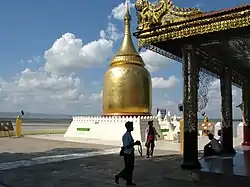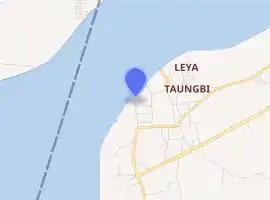Bupaya Pagoda
Bupaya Pagoda (Burmese: ဗူးဘုရား,pronounced [bú pʰəjá]) is a notable pagoda located in Bagan (formerly Pagan), in Myanmar, at a bend on the right bank of the Ayeyarwady River. The small pagoda, which has a bulbous shaped dome, is widely believed to have been built by the third King of Pagan, Pyusawhti who ruled from 168 to 243 AD.[1][2] It is one of the most notable shrines among the thousands of new or ruined Pagodas in Pagan, which is located about 90 miles (140 km) south of Mandalay.[3][4][5]
| Bupaya Pagoda | |
|---|---|
 Bupaya Pagoda | |

| |
| General information | |
| Type | Pilgrim and missionary of Buddhism |
| Location | Bagan, Myanmar |
| Coordinates | 21°10′35″N 94°51′29″E |
| Completed | 2nd century or 11th century |
| Design and construction | |
| Architect | King Pyusawhti |
The original pagoda was completely destroyed in the 1975 earthquake. As result of this earthquake, the bulbous pagoda broke into pieces and fell into the river. It was, however, fully reconstructed using modern materials, with lesser adherence to the original design. Subsequently, it was built as a gilded superstructure.[6][7][8]
Etymology

The name 'Bupaya' is made up of two words 'bu' and 'paya' in the Burmese language. As the pagoda is bulbous and in the shape of gourd or pumpkin, the word 'Bu' in Burmese, which means "pumpkin" or "gourd" is the affixed to 'paya'. The word 'paya' means "pagoda". It is also said that King Pyusawhti, builder of the Pagoda, got the river bank deweeded as it was infested with gourd-like plant, considered a 'menace'.[8][9]
Legend
According to a legend, Pyusawti who built this pagoda, as a young man defeated "Five Great Menaces" that were detrimental to the interest of the city of Pagan. One of these five menaces was the extensive proliferation of the plant vines of gourd (at the location where the Bupaya Pagoda was built later). Subsequently, the then King pleased with the gallant act of Pyusawti gave him, as a reward, his daughter in marriage. Later, Pyusawti became the King of the region. During his reign, he built pagodas at each of the places where he had destroyed the 'Menaces'.[8]
Geography
The Pagoda is built on the edge of the Irrawaddy River (it is Myanmar's largest commercial waterway), within the walled city of Pagan (a large capital city of the Burmese Kingdom between the 11th and the 13th centuries), over a series of crenellated terraces. The river takes a bend at this location. It acted as a guide landmark to navigators. It was built amidst a huge bush.[2][4][8][10]
History
The dating of this pagoda has several versions. According to the earliest claimed historical records, the Bupaya Pagoda claimed as the oldest, was built in the 3rd century by the third king of Pagan, Pyusawdi, who ruled from 168 to 243 AD.[4][11] However, it is also reported that the pagoda was commissioned in the 2nd century by King Pyusawti.[1] On the basis of similar pagodas and city walls built in Pagan, it has been conjectured that Bupaya Pagoda was built in the 9th century or even 11th century.[6][9][12]
However, the old pagoda getting destroyed completely and falling into the Irrawaddy River during the 1975 earthquake, has indelibly scotched any arguments on the subject of its dating.[9]
Structure

In keeping with the tradition of building pagodas in Myanmar, the Bupaya Pagoda also conformed to the norms set for such structures. The pagoda had a massive gravity-type pyramidal profile. It was built with bricks and impressively decorated. It was a bell-shaped dome built over diminishing terraces. A finial crowned the dome. The pagoda enshrined Buddha's relics.[9][13]
However, the new Bupaya Pagoda built at the same location in 1976–78, after the earthquake, is a hollow reinforced concrete structure (replacing the traditional brick structure of the past). It has been built on the traditional plan of a polygonal base. The pagoda rises up in "a series of crenellated semi-circular terraces overlooking the river". It is now fully gilded (pictured). The pagoda is now a very distinct landmark on the shores of the Irrawaddy River.[9]
References
- Deland, Antoinette (1989). Fielding's Far East. Fielding Travel Books. p. 34. ISBN 0-688-08046-4. Retrieved 2010-03-20.
- Pictorial guide to Pagan. Burma. Archaeological Survey. 1963. p. 29. Retrieved 2010-03-20.
- Imperial gazetteer of India ..., Volume 19. Clarendon Press. 1908. p. 313. Retrieved 2010-03-20.
- Amended list of ancient monuments in Burma. Supdt., Govt. Printing and stationary. 1960. p. 10. Retrieved 2010-03-20.
- Win, U Lu Pe (1977). Pagodas of Pagan. s.n. p. 1. Retrieved 2010-03-20.
- Falconer, John; Luca Invernizzi Tettoni (2000). Burmese design and architecture. Tuttle Publishing. p. 27. ISBN 962-593-882-6. Retrieved 2010-03-20.
- "The Ancient Mon-, Pagan,Peru and nakoran Pathom" (PDF). Sunzi Library. p. 181. Retrieved 2010-03-20.
- "Pumpkin Pagoda [Bupaya Pagoda], Pagan, Upper Burma". British Library:Online Gallery. Retrieved 2010-03-21.
- "Bupaya Temple (built c. 850)". Oriental Architecture. Retrieved 2010-03-20.
- Herman, Maya; Maja Herman-Sekulić (1998). The jade window: images from Southeast Asia. Suk's Editions. p. 120. ISBN 974-7457-03-2. Retrieved 2010-03-20.
- Frédéric, Louis (1965). The temples and sculpture of Southeast Asia. Thames & Hudson. p. 57. Retrieved 2010-03-20.
- "The Pagan Pagodas". Bupaya Pagoda (Bu Pagoda). Archived from the original on 2010-03-17. Retrieved 2010-03-20.
- "Tour Pagan: Bagan Buddhist Archaeological site, Ayeyarwaddy river, Myanmar". Department of Architecture, Rangoon Institute of Technology in co-operation with the Department of Archaeology, The Ministry of Culture and Finance. 1989. Archived from the original on 2010-02-11. Retrieved 2010-03-20.
| Wikimedia Commons has media related to Bupaya. |